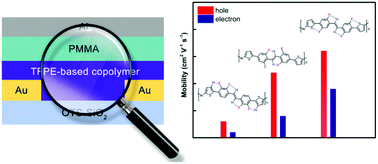Ambipolar tetrafluorodiphenylethene-based donor–acceptor copolymers: synthesis, properties, backbone conformation and fluorine-induced conformational locks†
Abstract
Herein, we present three kinds of tetrafluorodiphenylethene (TFPE)-based building blocks with multiple F⋯H–C and F⋯S conformational locks. Based on this, three copolymers PD23TFPE, PD26TFPE, and PD25TFPE were developed. Field-effect transistors based on these copolymers all exhibited ambipolar carrier transport characteristics, and the highest hole/electron mobilities were achieved in the PD25TFPE-based device. Thin film microstructure analyses suggest that PD25TFPE forms a highly ordered and dense thin film with an edge-on lamellar molecular packing. The crystallographic data of TFPE-based small molecules indicate that PD25TFPE assumes a linearly, fully “locked” conjugated backbone conformation, whereas PD23TFPE and PD26TFPE have a bent, fully “locked” or a linearly, partly “locked” conjugated backbone conformation. Our studies reveal the important influence of multiple conformation locks on tuning the backbone conformation, molecular packing mode in the solid state, and thus on the charge transport properties of polymer semiconductors.



 Please wait while we load your content...
Please wait while we load your content...